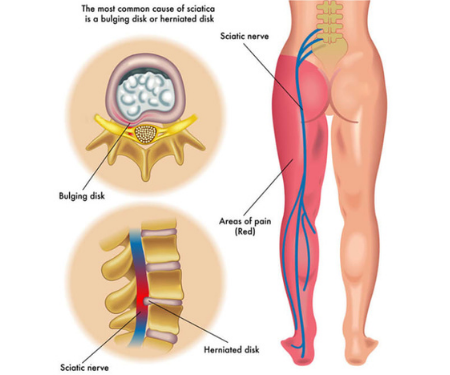Sciatica is a medical condition characterised by pain, numbness, and tingling sensation radiating from the low back to the legs, along the course of the sciatic nerve. These symptoms occur when the sciatic nerve is compressed.
Sciatica Leg Pain Treatment At Home: Tips for an Immediate Relief for Sciatica Leg Pain
Many people don't realise that with some non-invasive treatments, mild to moderate sciatica can resolve within 3 months. Depending on the cause, many sciatica cases resolve over time with a few simple self-care routines.
Here are a few ways to cure sciatica leg pain at the ease of your home with the help of some easy remedies.
1. Apply Cold and Hot Compresses
Alternating heat and ice therapy can provide immediate relief from sciatic nerve pain. Heat and ice both can also help relieve the painful muscle spasms that often accompany sciatica.
Heat therapy can help relieve lower back and leg pain caused by sciatica, as it can help to relax the stiff muscles, dull pain, and improve circulation. The heat can help your muscles and back relax and relieve any muscle spasms you may experience. Furthermore, heat should be used after the healing process has taken place, at least a week. You should ensure the treatment feels warm, and not uncomfortably hot.
A cold compress helps to reduce the pain by constricting the blood vessels and reducing the blood flow, thus reducing the inflammation in the affected region. Using ice therapy at home is very straightforward. Simply grab a few ice cubes from your freezer, wrap them in a towel, and relax.
2. Use Topical Pain Medications
Patients can relieve sciatica with the use of over-the-counter medications like NSAIDs.
Due to their localised action, gels and ointments containing camphor, methyl salicylate, trolamine salicylate, capsaicin, menthol, and/or cannabidiol (CBD) can help provide immediate relief.
In order to create a numbing effect and reduce inflammation, the medications alter the blood flow to the sore area. Applying the suggested amount on the rear pelvis in a circular motion that produces a massaging effect to the sore area is beneficial.
3. Physiotherapy
Massaging the affected area is found to be very effective as it increases blood circulation that further improves the condition.
Exercise plays a major role in the treatment of sciatica. A routine exercise program including strengthening and stretching exercises can help in controlling acute sciatica as well as in controlling future recurrence, by relieving the pain and tension in and around the sciatic nerve.
4. Aromatherapy
Compared to placebos and control treatments, essential oils and aromatherapy have been found to offer significant therapeutic benefits. Moreover, only treating the condition is not enough, rather treating the cause behind it makes the treatment more effective.
Gently massaging the affected area with the help of any of the essential oils which are listed below is found to be intensely beneficial. In every case, massaging is not appropriate, hence baths with either of these essential oils would work too.
Here are some of the best essential oils that can be used for aromatherapy:
Lavender Essential Oil
Rosemary Essential Oil
Marjoram Essential Oil
Eucalyptus Essential Oil
Peppermint Essential Oil
Helichrysum Essential Oil
Ginger Essential Oil
All these several essential oils are not only effective for pain but also reduce inflammation.
Sciatica Leg Pain: Causes & Overview
Sciatica is a non-specific term used to describe various symptoms in the legs or back. Pain and other symptoms are usually more pronounced in the early stages of sciatica when compression and inflammation of the sciatic nerve peak.
Sciatica pain is a common problem, with the cause being either mechanical or non-mechanical. Mechanical causes could be due to a herniated disc, bone spur, spinal stenosis, spondylolisthesis, degenerative disc disease, vertebral fracture, or muscle spasm. Non-mechanical causes can be due to pregnancy, obesity, or poor posture.
Sciatica occurs when the sciatic nerve is pinched or compressed. The sciatic nerve is the longest nerve in the body that starts in the lower back, runs through the buttocks, and runs down the thighs and legs, therefore the symptoms can be felt along the course of the nerve.
A true sciatic nerve injury "sciatica" is actually rare, though the term "sciatica" is often used to describe any pain that originates in the lower back and radiates to the legs. But in true sciatica, there is pinching or inflammation of the sciatic nerve.
While it may seem impossible, sciatica often responds well to conservative treatment within 3 months in most cases, even if the pain is excruciating.
Final Thoughts
Relieving sciatic nerve pain at home with light exercise, massage, ice and heat therapy, proper posture, and medication can speed up recovery. While any injury or process that causes compression of the sciatic nerve can cause sciatic nerve pain, in many cases the specific cause of sciatic nerve pain may not be determined. The most common causes of sciatica may be a torn disc or a herniated disc, a narrowing of the spinal canal (called spinal stenosis), and trauma.
Taking care of your back, maintaining the correct posture, consuming a healthy diet, managing your weight, and improving your overall physical condition can help prevent sciatica. Staying active is an important measure to prevent sciatica. Physical therapy aims to improve the movements of the hip, pelvis, and spinal joints to reduce pressure on the sciatic nerve.
If pain is still present after about 12 weeks and conservative treatment hasn't helped, doctors may recommend surgery, depending on the cause of the sciatica symptoms. A person should see a doctor if home remedies do not work or if sciatica pain lasts for more than a few weeks.

Illustrations designed by freepik